IMA7002 - Business Development: Analysis of Robert Textile Recycling
VerifiedAdded on 2023/06/11
|36
|8309
|69
Report
AI Summary
This report provides a comprehensive analysis of Robert Textile Recycling Ltd, a UK-based company focused on textile recycling and its potential for business development. It explores the urgency of textile recycling due to environmental concerns and overconsumption, highlighting the company's role in diverting waste from landfills and providing affordable clothing to poorer regions. The report delves into the textile recycling process, including collection, sorting, and processing, and examines the advantages of mechanical and chemical recycling methods. It also discusses the challenges and opportunities for business development in the Nigerian textile industry, emphasizing sustainability and entrepreneurial initiatives. The report concludes by underscoring the importance of Robert Textile Recycling's efforts in promoting a more sustainable and environmentally conscious approach to the textile industry.
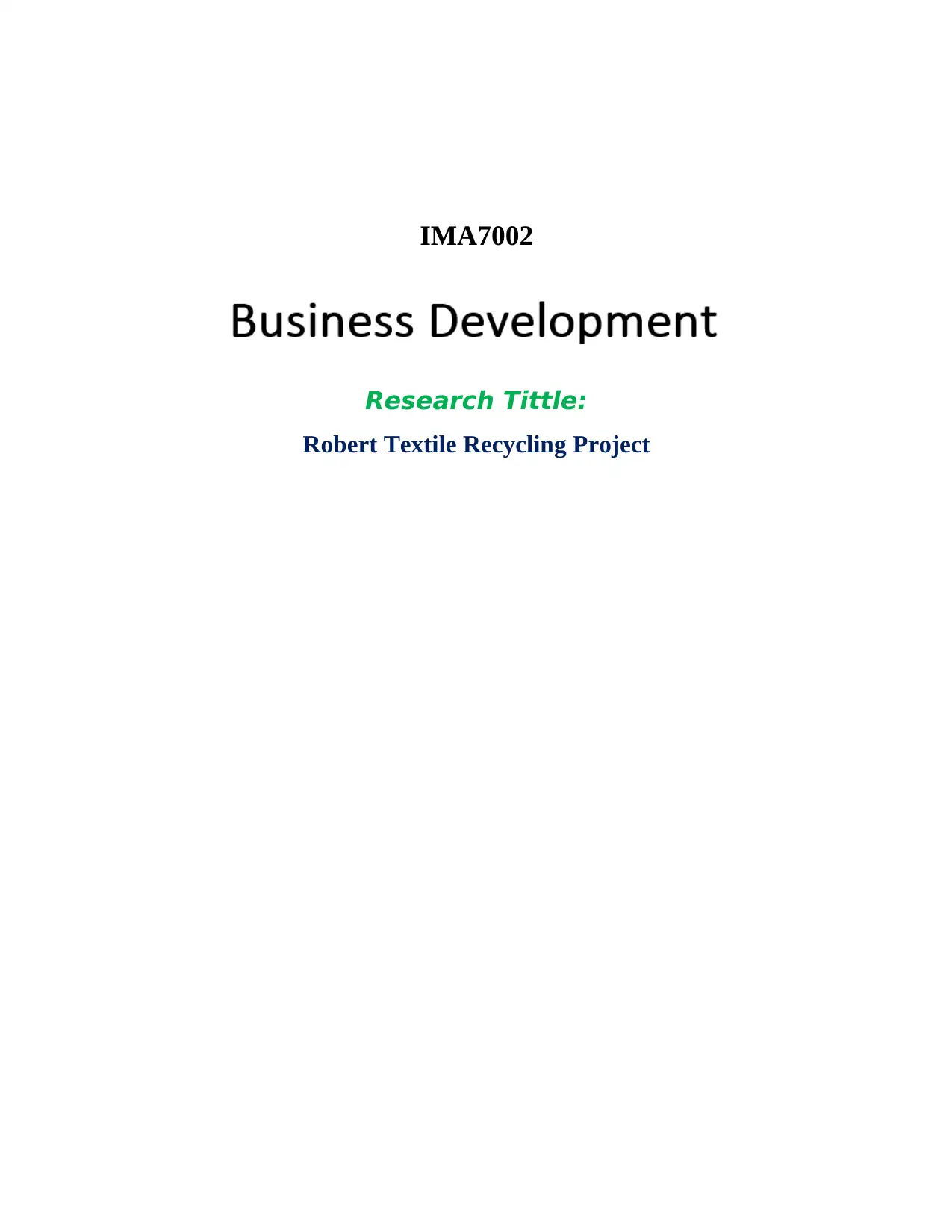
IMA7002
Research Tittle:
Robert Textile Recycling Project
Research Tittle:
Robert Textile Recycling Project
Paraphrase This Document
Need a fresh take? Get an instant paraphrase of this document with our AI Paraphraser
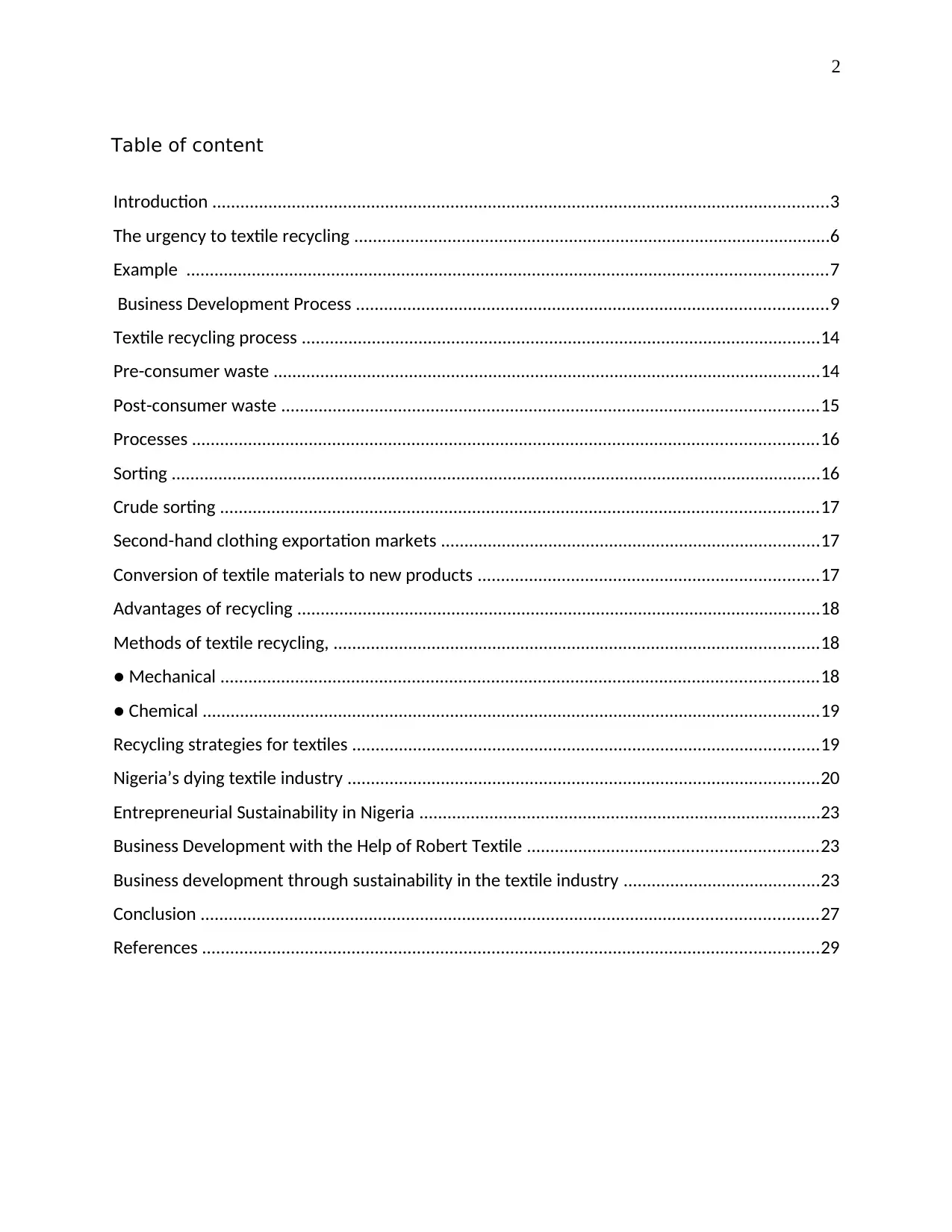
2
Table of content
Introduction ....................................................................................................................................3
The urgency to textile recycling ......................................................................................................6
Example .........................................................................................................................................7
Business Development Process .....................................................................................................9
Textile recycling process ...............................................................................................................14
Pre-consumer waste .....................................................................................................................14
Post-consumer waste ...................................................................................................................15
Processes ......................................................................................................................................16
Sorting ...........................................................................................................................................16
Crude sorting ................................................................................................................................17
Second-hand clothing exportation markets .................................................................................17
Conversion of textile materials to new products .........................................................................17
Advantages of recycling ................................................................................................................18
Methods of textile recycling, ........................................................................................................18
● Mechanical ................................................................................................................................18
● Chemical ....................................................................................................................................19
Recycling strategies for textiles ....................................................................................................19
Nigeria’s dying textile industry .....................................................................................................20
Entrepreneurial Sustainability in Nigeria ......................................................................................23
Business Development with the Help of Robert Textile ..............................................................23
Business development through sustainability in the textile industry ..........................................23
Conclusion ....................................................................................................................................27
References ....................................................................................................................................29
Table of content
Introduction ....................................................................................................................................3
The urgency to textile recycling ......................................................................................................6
Example .........................................................................................................................................7
Business Development Process .....................................................................................................9
Textile recycling process ...............................................................................................................14
Pre-consumer waste .....................................................................................................................14
Post-consumer waste ...................................................................................................................15
Processes ......................................................................................................................................16
Sorting ...........................................................................................................................................16
Crude sorting ................................................................................................................................17
Second-hand clothing exportation markets .................................................................................17
Conversion of textile materials to new products .........................................................................17
Advantages of recycling ................................................................................................................18
Methods of textile recycling, ........................................................................................................18
● Mechanical ................................................................................................................................18
● Chemical ....................................................................................................................................19
Recycling strategies for textiles ....................................................................................................19
Nigeria’s dying textile industry .....................................................................................................20
Entrepreneurial Sustainability in Nigeria ......................................................................................23
Business Development with the Help of Robert Textile ..............................................................23
Business development through sustainability in the textile industry ..........................................23
Conclusion ....................................................................................................................................27
References ....................................................................................................................................29
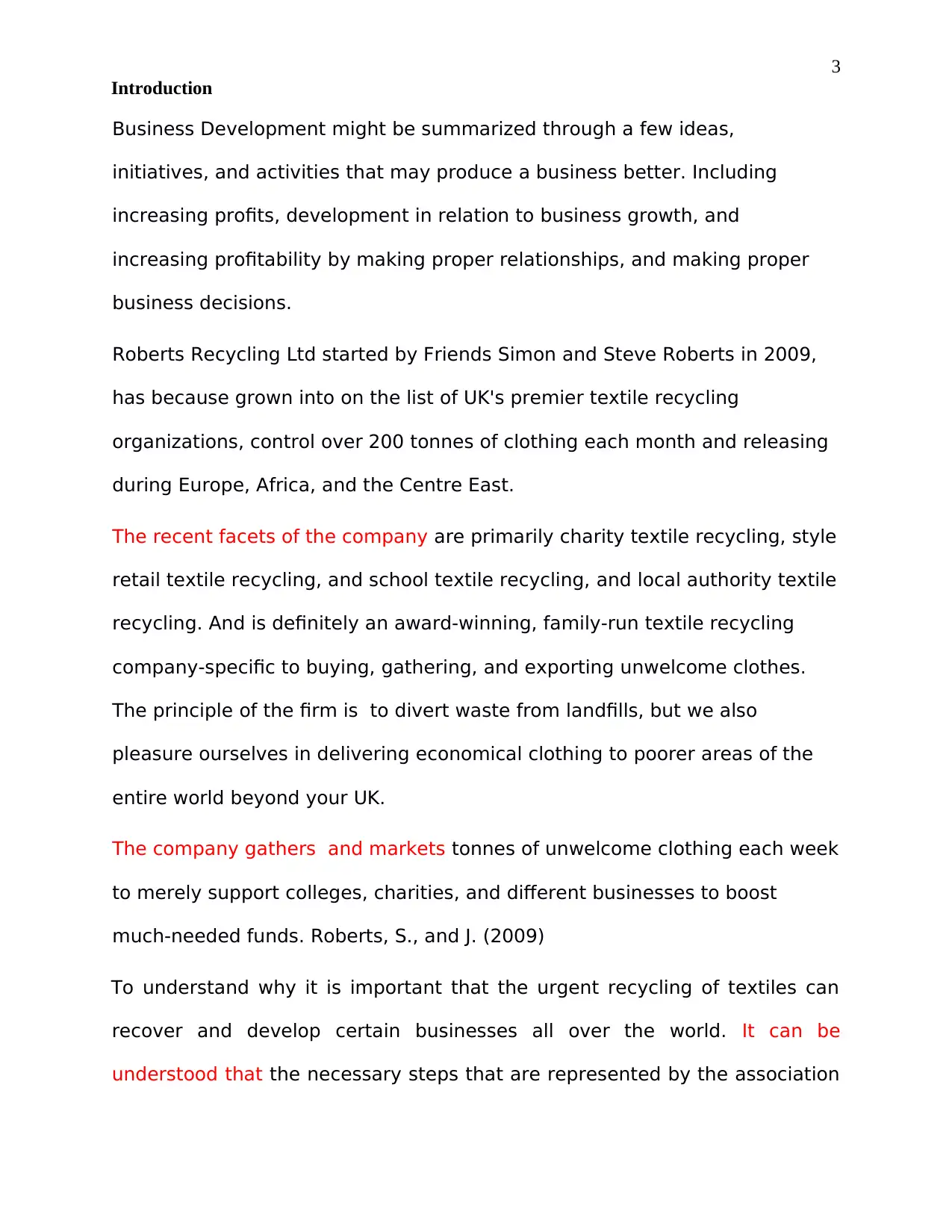
3
Introduction
Business Development might be summarized through a few ideas,
initiatives, and activities that may produce a business better. Including
increasing profits, development in relation to business growth, and
increasing profitability by making proper relationships, and making proper
business decisions.
Roberts Recycling Ltd started by Friends Simon and Steve Roberts in 2009,
has because grown into on the list of UK's premier textile recycling
organizations, control over 200 tonnes of clothing each month and releasing
during Europe, Africa, and the Centre East.
The recent facets of the company are primarily charity textile recycling, style
retail textile recycling, and school textile recycling, and local authority textile
recycling. And is definitely an award-winning, family-run textile recycling
company-specific to buying, gathering, and exporting unwelcome clothes.
The principle of the firm is to divert waste from landfills, but we also
pleasure ourselves in delivering economical clothing to poorer areas of the
entire world beyond your UK.
The company gathers and markets tonnes of unwelcome clothing each week
to merely support colleges, charities, and different businesses to boost
much-needed funds. Roberts, S., and J. (2009)
To understand why it is important that the urgent recycling of textiles can
recover and develop certain businesses all over the world. It can be
understood that the necessary steps that are represented by the association
Introduction
Business Development might be summarized through a few ideas,
initiatives, and activities that may produce a business better. Including
increasing profits, development in relation to business growth, and
increasing profitability by making proper relationships, and making proper
business decisions.
Roberts Recycling Ltd started by Friends Simon and Steve Roberts in 2009,
has because grown into on the list of UK's premier textile recycling
organizations, control over 200 tonnes of clothing each month and releasing
during Europe, Africa, and the Centre East.
The recent facets of the company are primarily charity textile recycling, style
retail textile recycling, and school textile recycling, and local authority textile
recycling. And is definitely an award-winning, family-run textile recycling
company-specific to buying, gathering, and exporting unwelcome clothes.
The principle of the firm is to divert waste from landfills, but we also
pleasure ourselves in delivering economical clothing to poorer areas of the
entire world beyond your UK.
The company gathers and markets tonnes of unwelcome clothing each week
to merely support colleges, charities, and different businesses to boost
much-needed funds. Roberts, S., and J. (2009)
To understand why it is important that the urgent recycling of textiles can
recover and develop certain businesses all over the world. It can be
understood that the necessary steps that are represented by the association
⊘ This is a preview!⊘
Do you want full access?
Subscribe today to unlock all pages.

Trusted by 1+ million students worldwide
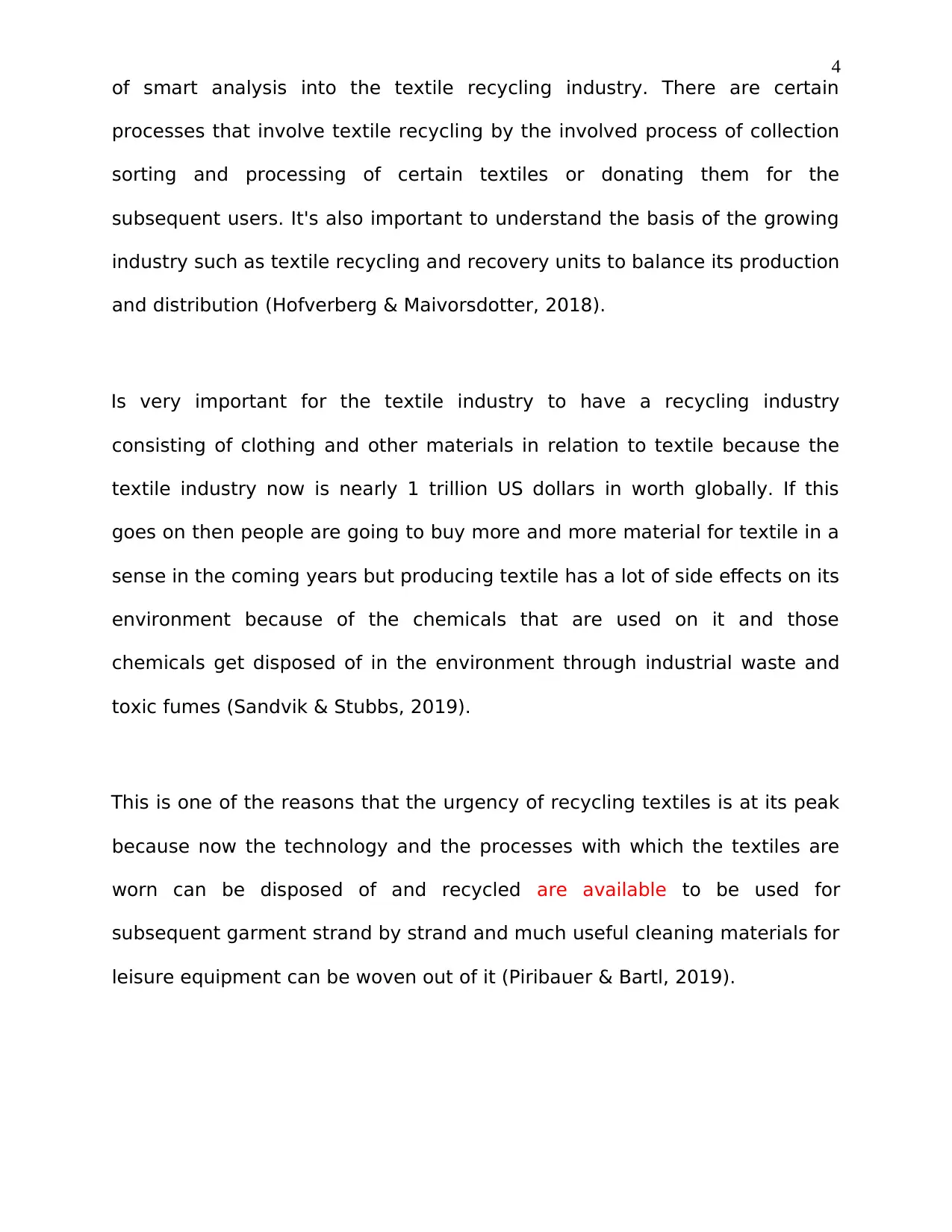
4
of smart analysis into the textile recycling industry. There are certain
processes that involve textile recycling by the involved process of collection
sorting and processing of certain textiles or donating them for the
subsequent users. It's also important to understand the basis of the growing
industry such as textile recycling and recovery units to balance its production
and distribution (Hofverberg & Maivorsdotter, 2018).
Is very important for the textile industry to have a recycling industry
consisting of clothing and other materials in relation to textile because the
textile industry now is nearly 1 trillion US dollars in worth globally. If this
goes on then people are going to buy more and more material for textile in a
sense in the coming years but producing textile has a lot of side effects on its
environment because of the chemicals that are used on it and those
chemicals get disposed of in the environment through industrial waste and
toxic fumes (Sandvik & Stubbs, 2019).
This is one of the reasons that the urgency of recycling textiles is at its peak
because now the technology and the processes with which the textiles are
worn can be disposed of and recycled are available to be used for
subsequent garment strand by strand and much useful cleaning materials for
leisure equipment can be woven out of it (Piribauer & Bartl, 2019).
of smart analysis into the textile recycling industry. There are certain
processes that involve textile recycling by the involved process of collection
sorting and processing of certain textiles or donating them for the
subsequent users. It's also important to understand the basis of the growing
industry such as textile recycling and recovery units to balance its production
and distribution (Hofverberg & Maivorsdotter, 2018).
Is very important for the textile industry to have a recycling industry
consisting of clothing and other materials in relation to textile because the
textile industry now is nearly 1 trillion US dollars in worth globally. If this
goes on then people are going to buy more and more material for textile in a
sense in the coming years but producing textile has a lot of side effects on its
environment because of the chemicals that are used on it and those
chemicals get disposed of in the environment through industrial waste and
toxic fumes (Sandvik & Stubbs, 2019).
This is one of the reasons that the urgency of recycling textiles is at its peak
because now the technology and the processes with which the textiles are
worn can be disposed of and recycled are available to be used for
subsequent garment strand by strand and much useful cleaning materials for
leisure equipment can be woven out of it (Piribauer & Bartl, 2019).
Paraphrase This Document
Need a fresh take? Get an instant paraphrase of this document with our AI Paraphraser
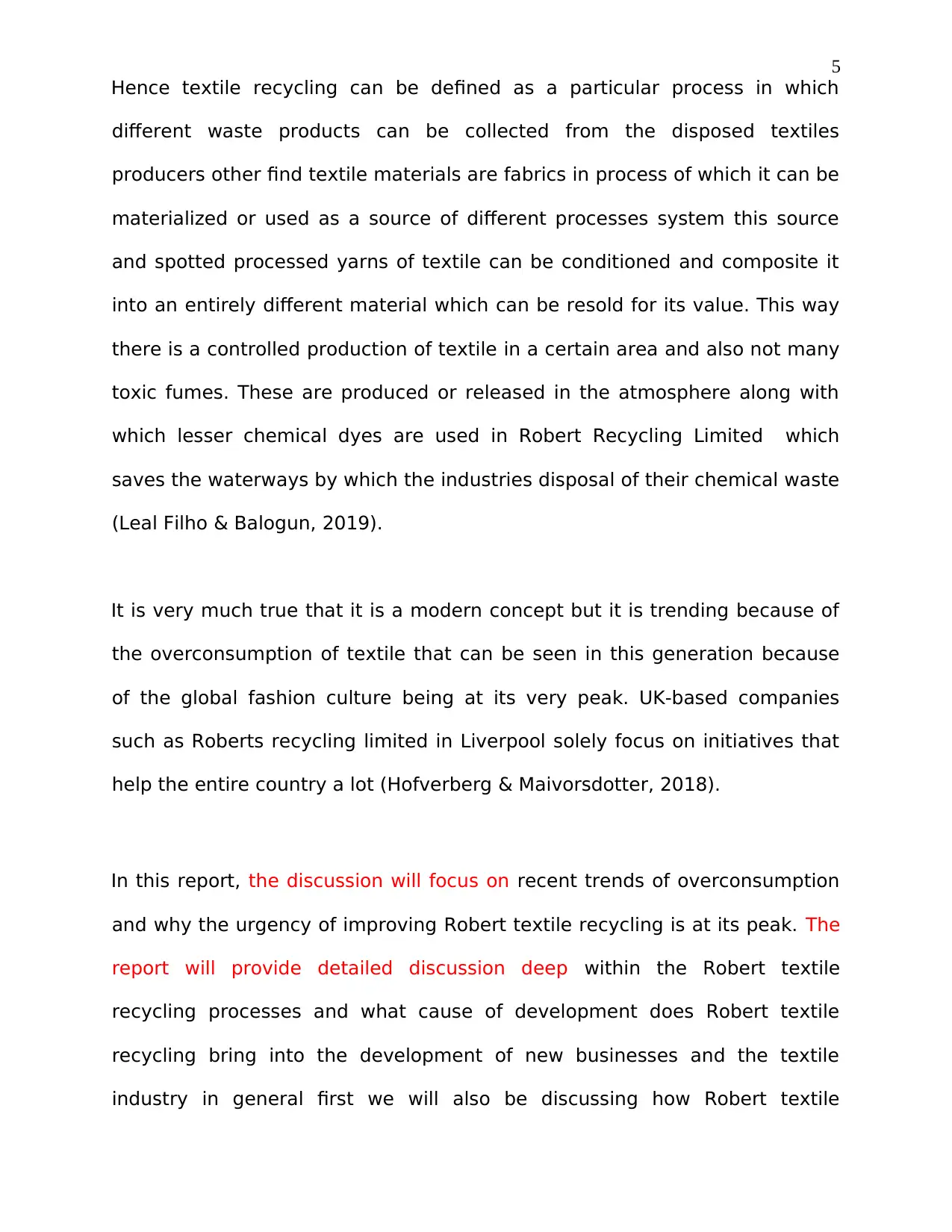
5
Hence textile recycling can be defined as a particular process in which
different waste products can be collected from the disposed textiles
producers other find textile materials are fabrics in process of which it can be
materialized or used as a source of different processes system this source
and spotted processed yarns of textile can be conditioned and composite it
into an entirely different material which can be resold for its value. This way
there is a controlled production of textile in a certain area and also not many
toxic fumes. These are produced or released in the atmosphere along with
which lesser chemical dyes are used in Robert Recycling Limited which
saves the waterways by which the industries disposal of their chemical waste
(Leal Filho & Balogun, 2019).
It is very much true that it is a modern concept but it is trending because of
the overconsumption of textile that can be seen in this generation because
of the global fashion culture being at its very peak. UK-based companies
such as Roberts recycling limited in Liverpool solely focus on initiatives that
help the entire country a lot (Hofverberg & Maivorsdotter, 2018).
In this report, the discussion will focus on recent trends of overconsumption
and why the urgency of improving Robert textile recycling is at its peak. The
report will provide detailed discussion deep within the Robert textile
recycling processes and what cause of development does Robert textile
recycling bring into the development of new businesses and the textile
industry in general first we will also be discussing how Robert textile
Hence textile recycling can be defined as a particular process in which
different waste products can be collected from the disposed textiles
producers other find textile materials are fabrics in process of which it can be
materialized or used as a source of different processes system this source
and spotted processed yarns of textile can be conditioned and composite it
into an entirely different material which can be resold for its value. This way
there is a controlled production of textile in a certain area and also not many
toxic fumes. These are produced or released in the atmosphere along with
which lesser chemical dyes are used in Robert Recycling Limited which
saves the waterways by which the industries disposal of their chemical waste
(Leal Filho & Balogun, 2019).
It is very much true that it is a modern concept but it is trending because of
the overconsumption of textile that can be seen in this generation because
of the global fashion culture being at its very peak. UK-based companies
such as Roberts recycling limited in Liverpool solely focus on initiatives that
help the entire country a lot (Hofverberg & Maivorsdotter, 2018).
In this report, the discussion will focus on recent trends of overconsumption
and why the urgency of improving Robert textile recycling is at its peak. The
report will provide detailed discussion deep within the Robert textile
recycling processes and what cause of development does Robert textile
recycling bring into the development of new businesses and the textile
industry in general first we will also be discussing how Robert textile
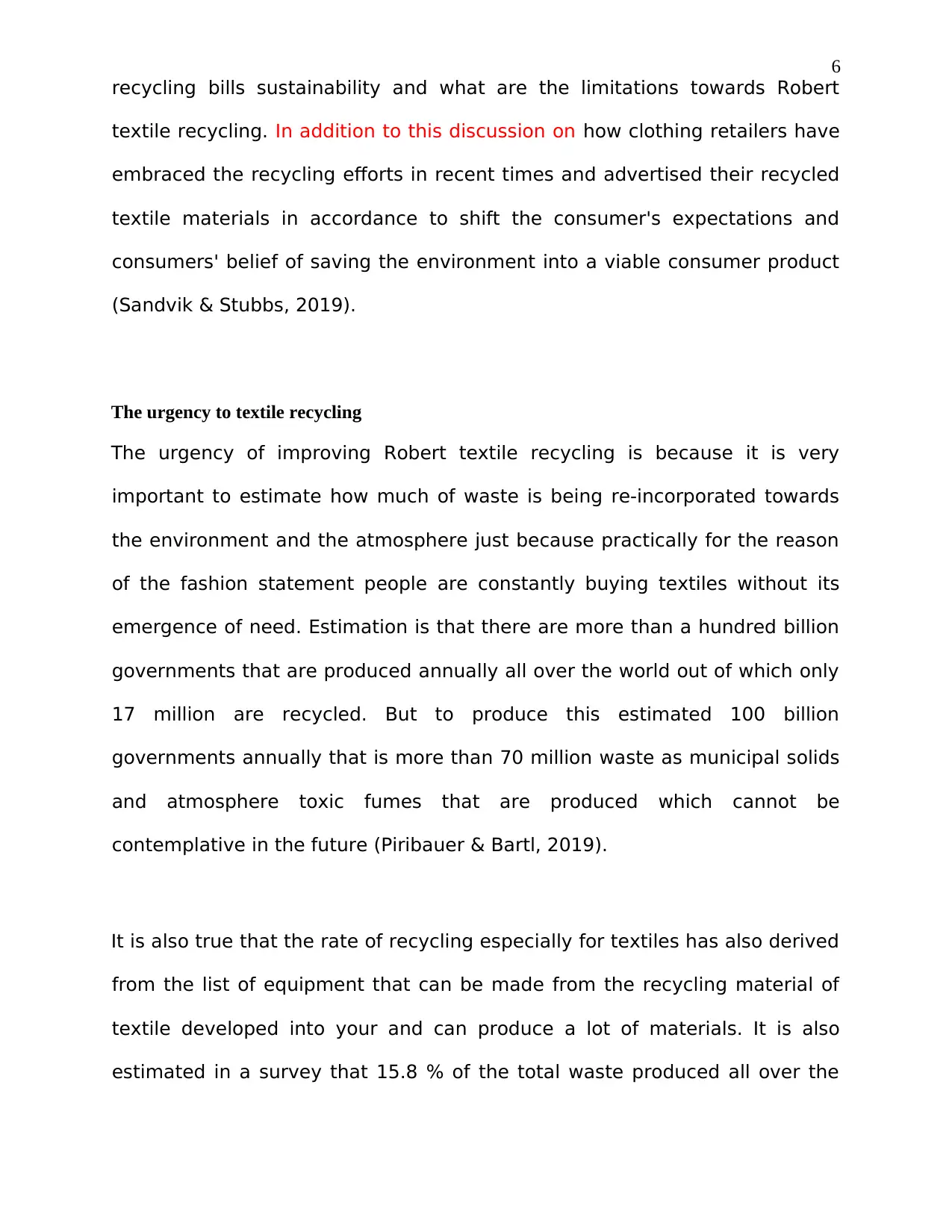
6
recycling bills sustainability and what are the limitations towards Robert
textile recycling. In addition to this discussion on how clothing retailers have
embraced the recycling efforts in recent times and advertised their recycled
textile materials in accordance to shift the consumer's expectations and
consumers' belief of saving the environment into a viable consumer product
(Sandvik & Stubbs, 2019).
The urgency to textile recycling
The urgency of improving Robert textile recycling is because it is very
important to estimate how much of waste is being re-incorporated towards
the environment and the atmosphere just because practically for the reason
of the fashion statement people are constantly buying textiles without its
emergence of need. Estimation is that there are more than a hundred billion
governments that are produced annually all over the world out of which only
17 million are recycled. But to produce this estimated 100 billion
governments annually that is more than 70 million waste as municipal solids
and atmosphere toxic fumes that are produced which cannot be
contemplative in the future (Piribauer & Bartl, 2019).
It is also true that the rate of recycling especially for textiles has also derived
from the list of equipment that can be made from the recycling material of
textile developed into your and can produce a lot of materials. It is also
estimated in a survey that 15.8 % of the total waste produced all over the
recycling bills sustainability and what are the limitations towards Robert
textile recycling. In addition to this discussion on how clothing retailers have
embraced the recycling efforts in recent times and advertised their recycled
textile materials in accordance to shift the consumer's expectations and
consumers' belief of saving the environment into a viable consumer product
(Sandvik & Stubbs, 2019).
The urgency to textile recycling
The urgency of improving Robert textile recycling is because it is very
important to estimate how much of waste is being re-incorporated towards
the environment and the atmosphere just because practically for the reason
of the fashion statement people are constantly buying textiles without its
emergence of need. Estimation is that there are more than a hundred billion
governments that are produced annually all over the world out of which only
17 million are recycled. But to produce this estimated 100 billion
governments annually that is more than 70 million waste as municipal solids
and atmosphere toxic fumes that are produced which cannot be
contemplative in the future (Piribauer & Bartl, 2019).
It is also true that the rate of recycling especially for textiles has also derived
from the list of equipment that can be made from the recycling material of
textile developed into your and can produce a lot of materials. It is also
estimated in a survey that 15.8 % of the total waste produced all over the
⊘ This is a preview!⊘
Do you want full access?
Subscribe today to unlock all pages.

Trusted by 1+ million students worldwide
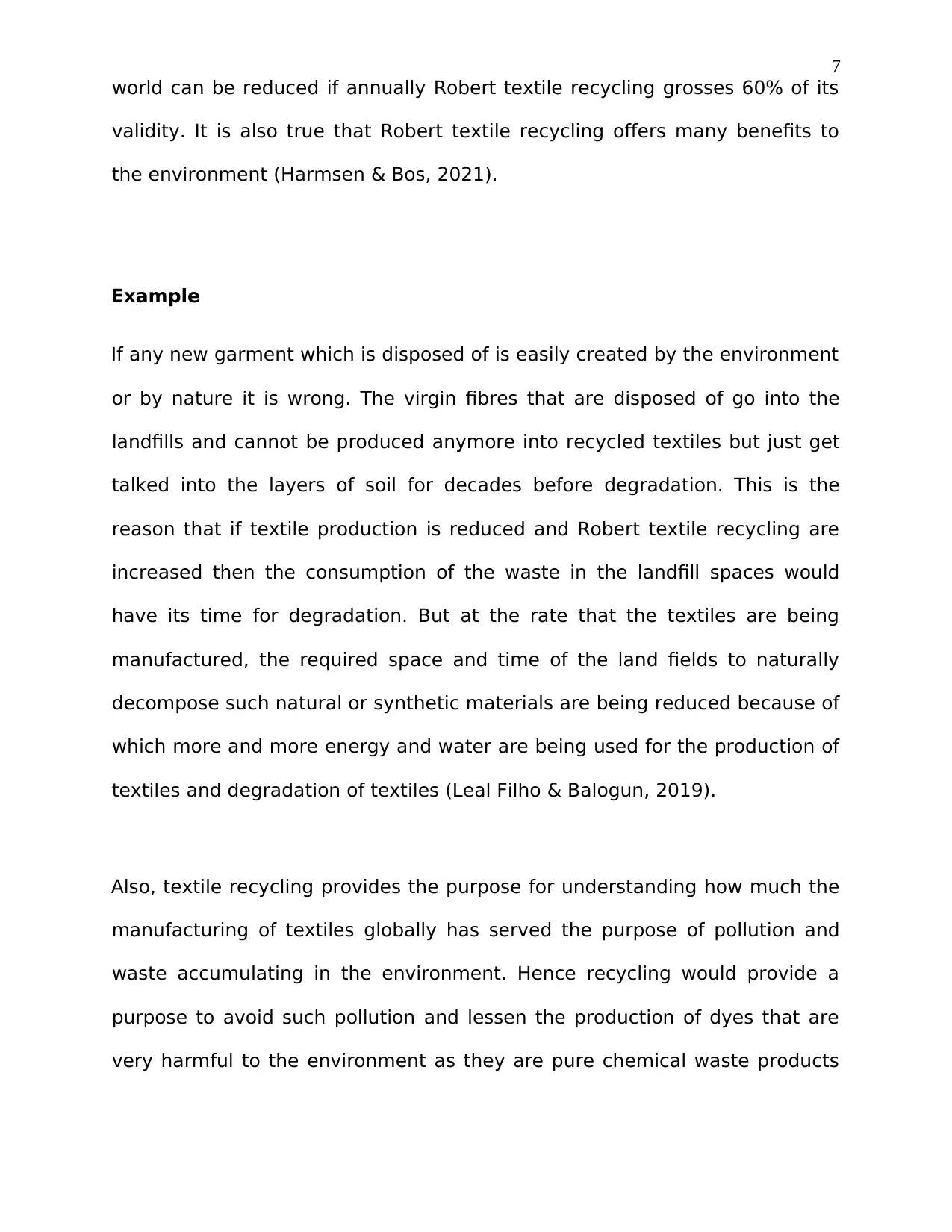
7
world can be reduced if annually Robert textile recycling grosses 60% of its
validity. It is also true that Robert textile recycling offers many benefits to
the environment (Harmsen & Bos, 2021).
Example
If any new garment which is disposed of is easily created by the environment
or by nature it is wrong. The virgin fibres that are disposed of go into the
landfills and cannot be produced anymore into recycled textiles but just get
talked into the layers of soil for decades before degradation. This is the
reason that if textile production is reduced and Robert textile recycling are
increased then the consumption of the waste in the landfill spaces would
have its time for degradation. But at the rate that the textiles are being
manufactured, the required space and time of the land fields to naturally
decompose such natural or synthetic materials are being reduced because of
which more and more energy and water are being used for the production of
textiles and degradation of textiles (Leal Filho & Balogun, 2019).
Also, textile recycling provides the purpose for understanding how much the
manufacturing of textiles globally has served the purpose of pollution and
waste accumulating in the environment. Hence recycling would provide a
purpose to avoid such pollution and lessen the production of dyes that are
very harmful to the environment as they are pure chemical waste products
world can be reduced if annually Robert textile recycling grosses 60% of its
validity. It is also true that Robert textile recycling offers many benefits to
the environment (Harmsen & Bos, 2021).
Example
If any new garment which is disposed of is easily created by the environment
or by nature it is wrong. The virgin fibres that are disposed of go into the
landfills and cannot be produced anymore into recycled textiles but just get
talked into the layers of soil for decades before degradation. This is the
reason that if textile production is reduced and Robert textile recycling are
increased then the consumption of the waste in the landfill spaces would
have its time for degradation. But at the rate that the textiles are being
manufactured, the required space and time of the land fields to naturally
decompose such natural or synthetic materials are being reduced because of
which more and more energy and water are being used for the production of
textiles and degradation of textiles (Leal Filho & Balogun, 2019).
Also, textile recycling provides the purpose for understanding how much the
manufacturing of textiles globally has served the purpose of pollution and
waste accumulating in the environment. Hence recycling would provide a
purpose to avoid such pollution and lessen the production of dyes that are
very harmful to the environment as they are pure chemical waste products
Paraphrase This Document
Need a fresh take? Get an instant paraphrase of this document with our AI Paraphraser
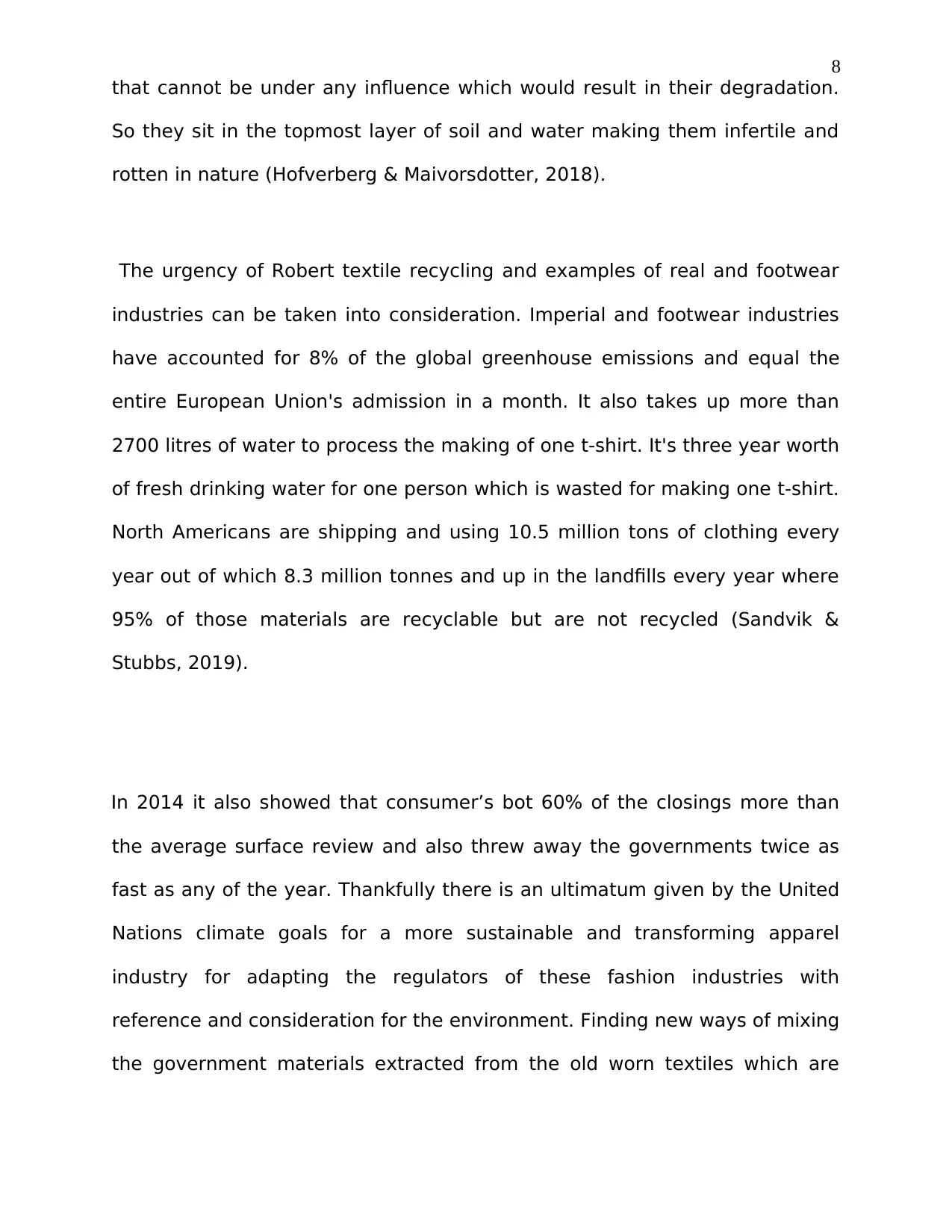
8
that cannot be under any influence which would result in their degradation.
So they sit in the topmost layer of soil and water making them infertile and
rotten in nature (Hofverberg & Maivorsdotter, 2018).
The urgency of Robert textile recycling and examples of real and footwear
industries can be taken into consideration. Imperial and footwear industries
have accounted for 8% of the global greenhouse emissions and equal the
entire European Union's admission in a month. It also takes up more than
2700 litres of water to process the making of one t-shirt. It's three year worth
of fresh drinking water for one person which is wasted for making one t-shirt.
North Americans are shipping and using 10.5 million tons of clothing every
year out of which 8.3 million tonnes and up in the landfills every year where
95% of those materials are recyclable but are not recycled (Sandvik &
Stubbs, 2019).
In 2014 it also showed that consumer’s bot 60% of the closings more than
the average surface review and also threw away the governments twice as
fast as any of the year. Thankfully there is an ultimatum given by the United
Nations climate goals for a more sustainable and transforming apparel
industry for adapting the regulators of these fashion industries with
reference and consideration for the environment. Finding new ways of mixing
the government materials extracted from the old worn textiles which are
that cannot be under any influence which would result in their degradation.
So they sit in the topmost layer of soil and water making them infertile and
rotten in nature (Hofverberg & Maivorsdotter, 2018).
The urgency of Robert textile recycling and examples of real and footwear
industries can be taken into consideration. Imperial and footwear industries
have accounted for 8% of the global greenhouse emissions and equal the
entire European Union's admission in a month. It also takes up more than
2700 litres of water to process the making of one t-shirt. It's three year worth
of fresh drinking water for one person which is wasted for making one t-shirt.
North Americans are shipping and using 10.5 million tons of clothing every
year out of which 8.3 million tonnes and up in the landfills every year where
95% of those materials are recyclable but are not recycled (Sandvik &
Stubbs, 2019).
In 2014 it also showed that consumer’s bot 60% of the closings more than
the average surface review and also threw away the governments twice as
fast as any of the year. Thankfully there is an ultimatum given by the United
Nations climate goals for a more sustainable and transforming apparel
industry for adapting the regulators of these fashion industries with
reference and consideration for the environment. Finding new ways of mixing
the government materials extracted from the old worn textiles which are
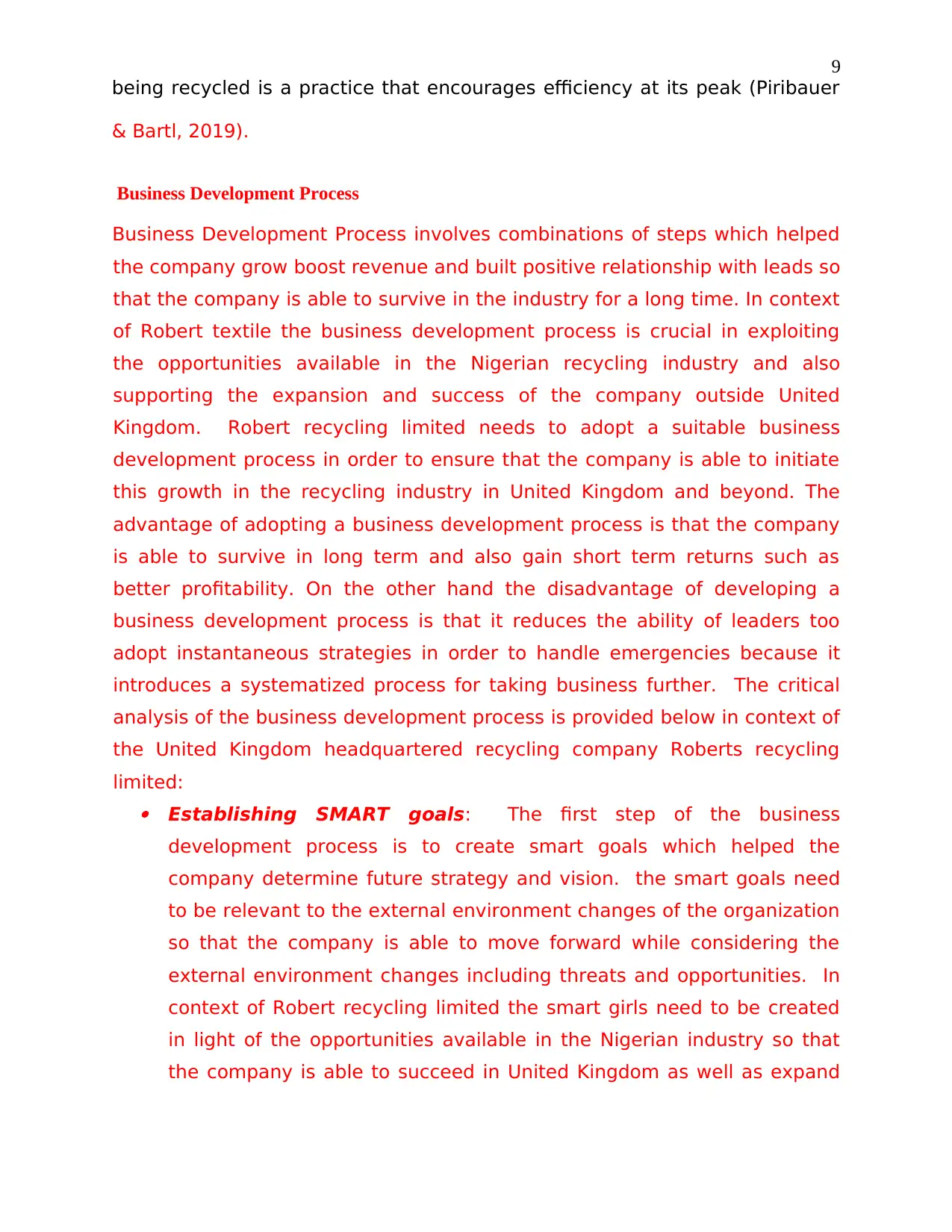
9
being recycled is a practice that encourages efficiency at its peak (Piribauer
& Bartl, 2019).
Business Development Process
Business Development Process involves combinations of steps which helped
the company grow boost revenue and built positive relationship with leads so
that the company is able to survive in the industry for a long time. In context
of Robert textile the business development process is crucial in exploiting
the opportunities available in the Nigerian recycling industry and also
supporting the expansion and success of the company outside United
Kingdom. Robert recycling limited needs to adopt a suitable business
development process in order to ensure that the company is able to initiate
this growth in the recycling industry in United Kingdom and beyond. The
advantage of adopting a business development process is that the company
is able to survive in long term and also gain short term returns such as
better profitability. On the other hand the disadvantage of developing a
business development process is that it reduces the ability of leaders too
adopt instantaneous strategies in order to handle emergencies because it
introduces a systematized process for taking business further. The critical
analysis of the business development process is provided below in context of
the United Kingdom headquartered recycling company Roberts recycling
limited: Establishing SMART goals: The first step of the business
development process is to create smart goals which helped the
company determine future strategy and vision. the smart goals need
to be relevant to the external environment changes of the organization
so that the company is able to move forward while considering the
external environment changes including threats and opportunities. In
context of Robert recycling limited the smart girls need to be created
in light of the opportunities available in the Nigerian industry so that
the company is able to succeed in United Kingdom as well as expand
being recycled is a practice that encourages efficiency at its peak (Piribauer
& Bartl, 2019).
Business Development Process
Business Development Process involves combinations of steps which helped
the company grow boost revenue and built positive relationship with leads so
that the company is able to survive in the industry for a long time. In context
of Robert textile the business development process is crucial in exploiting
the opportunities available in the Nigerian recycling industry and also
supporting the expansion and success of the company outside United
Kingdom. Robert recycling limited needs to adopt a suitable business
development process in order to ensure that the company is able to initiate
this growth in the recycling industry in United Kingdom and beyond. The
advantage of adopting a business development process is that the company
is able to survive in long term and also gain short term returns such as
better profitability. On the other hand the disadvantage of developing a
business development process is that it reduces the ability of leaders too
adopt instantaneous strategies in order to handle emergencies because it
introduces a systematized process for taking business further. The critical
analysis of the business development process is provided below in context of
the United Kingdom headquartered recycling company Roberts recycling
limited: Establishing SMART goals: The first step of the business
development process is to create smart goals which helped the
company determine future strategy and vision. the smart goals need
to be relevant to the external environment changes of the organization
so that the company is able to move forward while considering the
external environment changes including threats and opportunities. In
context of Robert recycling limited the smart girls need to be created
in light of the opportunities available in the Nigerian industry so that
the company is able to succeed in United Kingdom as well as expand
⊘ This is a preview!⊘
Do you want full access?
Subscribe today to unlock all pages.

Trusted by 1+ million students worldwide
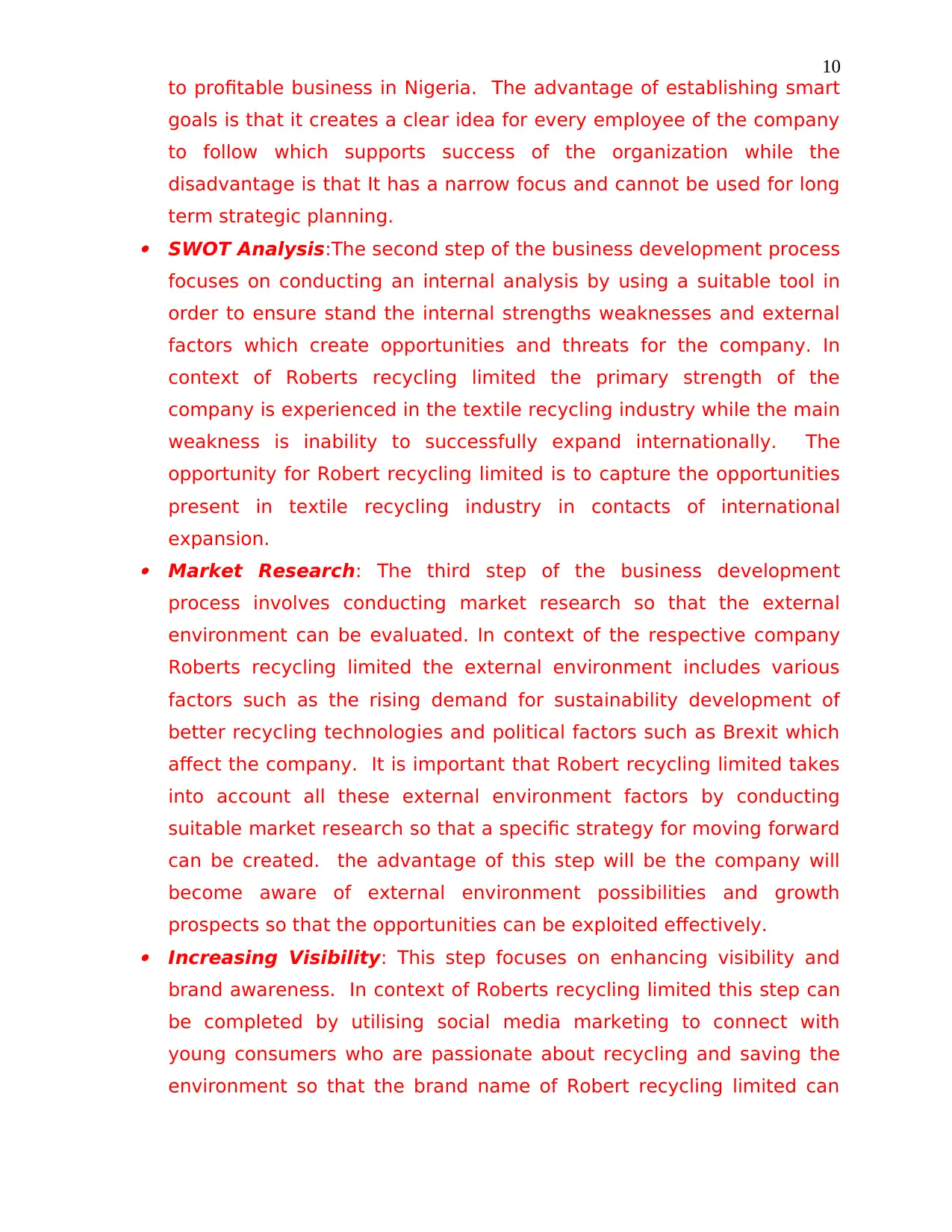
10
to profitable business in Nigeria. The advantage of establishing smart
goals is that it creates a clear idea for every employee of the company
to follow which supports success of the organization while the
disadvantage is that It has a narrow focus and cannot be used for long
term strategic planning. SWOT Analysis:The second step of the business development process
focuses on conducting an internal analysis by using a suitable tool in
order to ensure stand the internal strengths weaknesses and external
factors which create opportunities and threats for the company. In
context of Roberts recycling limited the primary strength of the
company is experienced in the textile recycling industry while the main
weakness is inability to successfully expand internationally. The
opportunity for Robert recycling limited is to capture the opportunities
present in textile recycling industry in contacts of international
expansion. Market Research: The third step of the business development
process involves conducting market research so that the external
environment can be evaluated. In context of the respective company
Roberts recycling limited the external environment includes various
factors such as the rising demand for sustainability development of
better recycling technologies and political factors such as Brexit which
affect the company. It is important that Robert recycling limited takes
into account all these external environment factors by conducting
suitable market research so that a specific strategy for moving forward
can be created. the advantage of this step will be the company will
become aware of external environment possibilities and growth
prospects so that the opportunities can be exploited effectively. Increasing Visibility: This step focuses on enhancing visibility and
brand awareness. In context of Roberts recycling limited this step can
be completed by utilising social media marketing to connect with
young consumers who are passionate about recycling and saving the
environment so that the brand name of Robert recycling limited can
to profitable business in Nigeria. The advantage of establishing smart
goals is that it creates a clear idea for every employee of the company
to follow which supports success of the organization while the
disadvantage is that It has a narrow focus and cannot be used for long
term strategic planning. SWOT Analysis:The second step of the business development process
focuses on conducting an internal analysis by using a suitable tool in
order to ensure stand the internal strengths weaknesses and external
factors which create opportunities and threats for the company. In
context of Roberts recycling limited the primary strength of the
company is experienced in the textile recycling industry while the main
weakness is inability to successfully expand internationally. The
opportunity for Robert recycling limited is to capture the opportunities
present in textile recycling industry in contacts of international
expansion. Market Research: The third step of the business development
process involves conducting market research so that the external
environment can be evaluated. In context of the respective company
Roberts recycling limited the external environment includes various
factors such as the rising demand for sustainability development of
better recycling technologies and political factors such as Brexit which
affect the company. It is important that Robert recycling limited takes
into account all these external environment factors by conducting
suitable market research so that a specific strategy for moving forward
can be created. the advantage of this step will be the company will
become aware of external environment possibilities and growth
prospects so that the opportunities can be exploited effectively. Increasing Visibility: This step focuses on enhancing visibility and
brand awareness. In context of Roberts recycling limited this step can
be completed by utilising social media marketing to connect with
young consumers who are passionate about recycling and saving the
environment so that the brand name of Robert recycling limited can
Paraphrase This Document
Need a fresh take? Get an instant paraphrase of this document with our AI Paraphraser
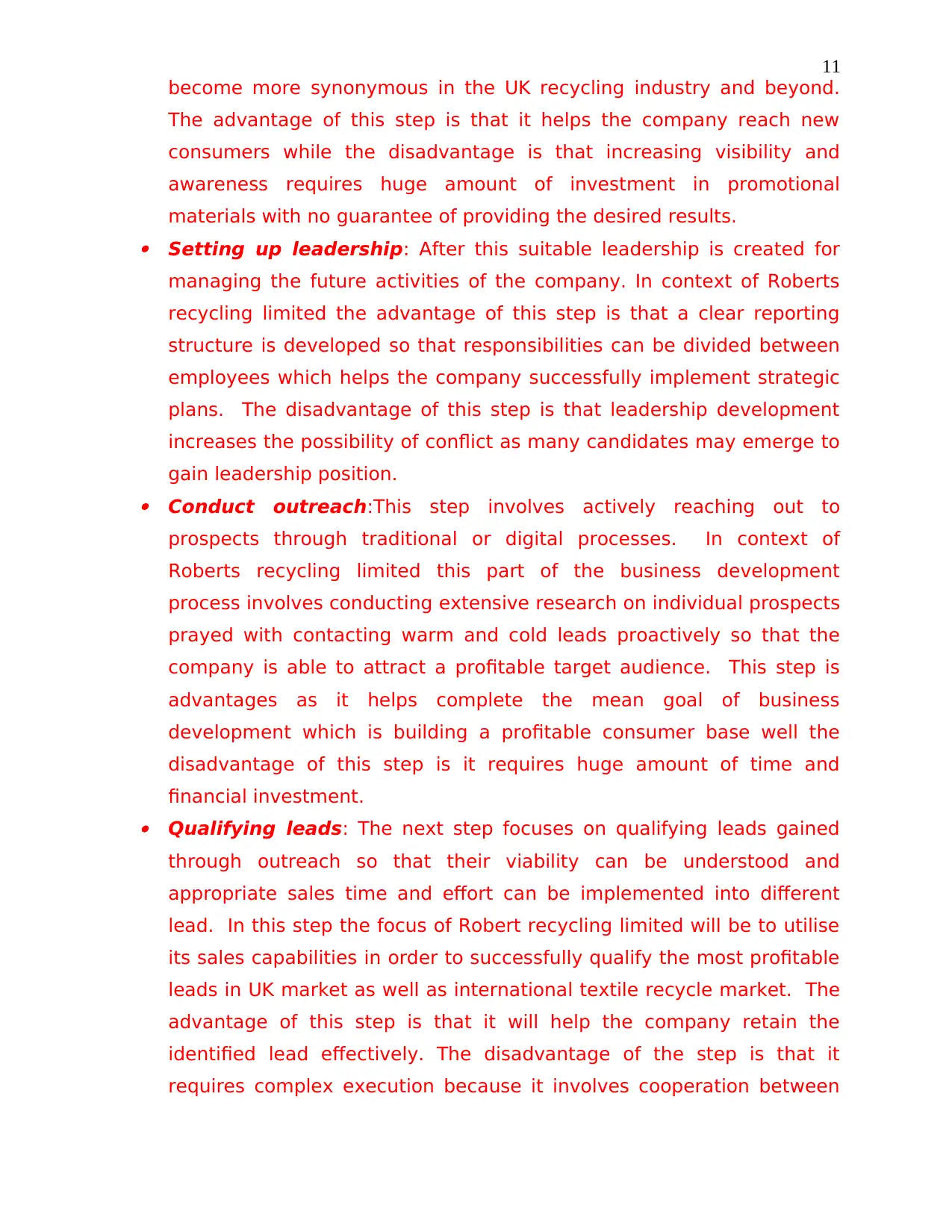
11
become more synonymous in the UK recycling industry and beyond.
The advantage of this step is that it helps the company reach new
consumers while the disadvantage is that increasing visibility and
awareness requires huge amount of investment in promotional
materials with no guarantee of providing the desired results. Setting up leadership: After this suitable leadership is created for
managing the future activities of the company. In context of Roberts
recycling limited the advantage of this step is that a clear reporting
structure is developed so that responsibilities can be divided between
employees which helps the company successfully implement strategic
plans. The disadvantage of this step is that leadership development
increases the possibility of conflict as many candidates may emerge to
gain leadership position. Conduct outreach:This step involves actively reaching out to
prospects through traditional or digital processes. In context of
Roberts recycling limited this part of the business development
process involves conducting extensive research on individual prospects
prayed with contacting warm and cold leads proactively so that the
company is able to attract a profitable target audience. This step is
advantages as it helps complete the mean goal of business
development which is building a profitable consumer base well the
disadvantage of this step is it requires huge amount of time and
financial investment. Qualifying leads: The next step focuses on qualifying leads gained
through outreach so that their viability can be understood and
appropriate sales time and effort can be implemented into different
lead. In this step the focus of Robert recycling limited will be to utilise
its sales capabilities in order to successfully qualify the most profitable
leads in UK market as well as international textile recycle market. The
advantage of this step is that it will help the company retain the
identified lead effectively. The disadvantage of the step is that it
requires complex execution because it involves cooperation between
become more synonymous in the UK recycling industry and beyond.
The advantage of this step is that it helps the company reach new
consumers while the disadvantage is that increasing visibility and
awareness requires huge amount of investment in promotional
materials with no guarantee of providing the desired results. Setting up leadership: After this suitable leadership is created for
managing the future activities of the company. In context of Roberts
recycling limited the advantage of this step is that a clear reporting
structure is developed so that responsibilities can be divided between
employees which helps the company successfully implement strategic
plans. The disadvantage of this step is that leadership development
increases the possibility of conflict as many candidates may emerge to
gain leadership position. Conduct outreach:This step involves actively reaching out to
prospects through traditional or digital processes. In context of
Roberts recycling limited this part of the business development
process involves conducting extensive research on individual prospects
prayed with contacting warm and cold leads proactively so that the
company is able to attract a profitable target audience. This step is
advantages as it helps complete the mean goal of business
development which is building a profitable consumer base well the
disadvantage of this step is it requires huge amount of time and
financial investment. Qualifying leads: The next step focuses on qualifying leads gained
through outreach so that their viability can be understood and
appropriate sales time and effort can be implemented into different
lead. In this step the focus of Robert recycling limited will be to utilise
its sales capabilities in order to successfully qualify the most profitable
leads in UK market as well as international textile recycle market. The
advantage of this step is that it will help the company retain the
identified lead effectively. The disadvantage of the step is that it
requires complex execution because it involves cooperation between
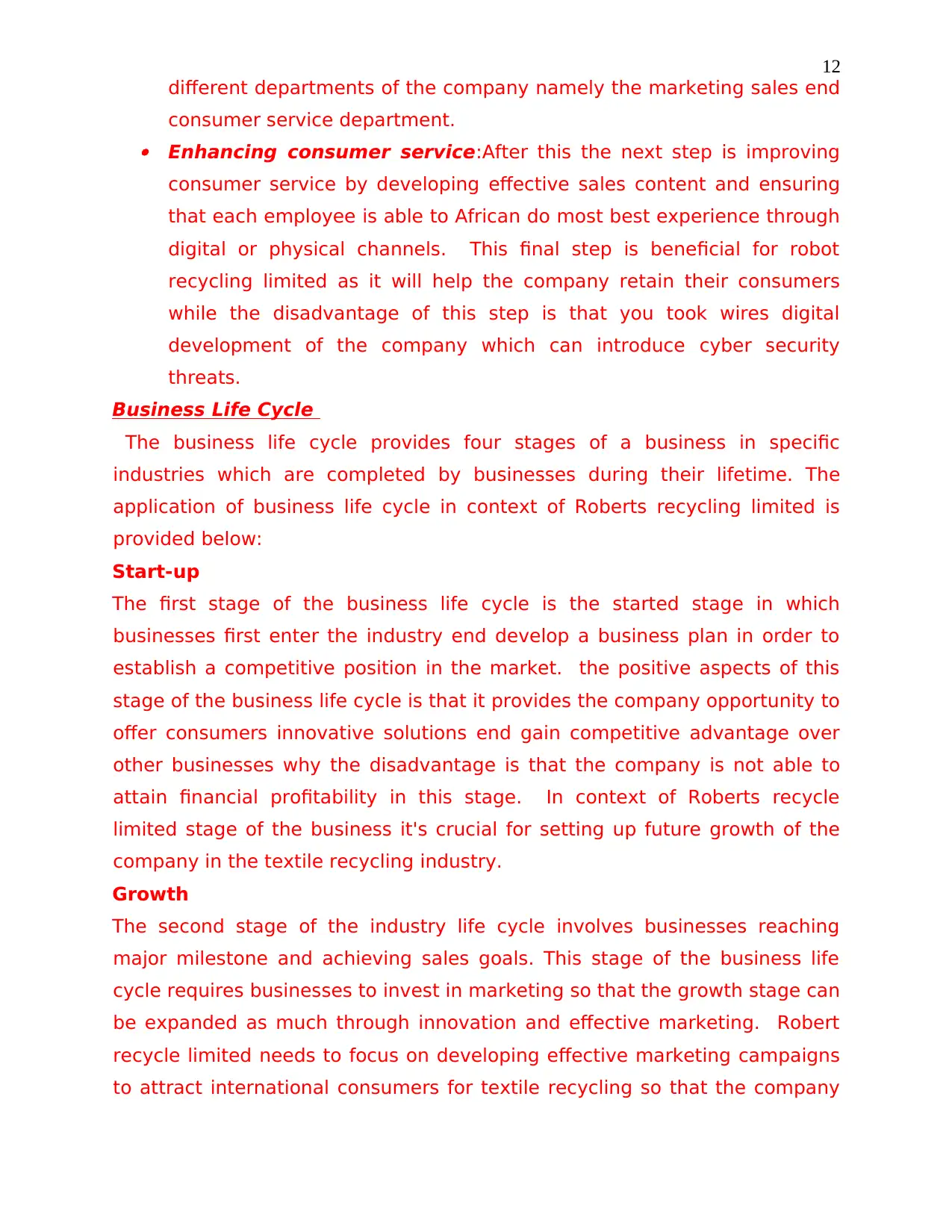
12
different departments of the company namely the marketing sales end
consumer service department. Enhancing consumer service:After this the next step is improving
consumer service by developing effective sales content and ensuring
that each employee is able to African do most best experience through
digital or physical channels. This final step is beneficial for robot
recycling limited as it will help the company retain their consumers
while the disadvantage of this step is that you took wires digital
development of the company which can introduce cyber security
threats.
Business Life Cycle
The business life cycle provides four stages of a business in specific
industries which are completed by businesses during their lifetime. The
application of business life cycle in context of Roberts recycling limited is
provided below:
Start-up
The first stage of the business life cycle is the started stage in which
businesses first enter the industry end develop a business plan in order to
establish a competitive position in the market. the positive aspects of this
stage of the business life cycle is that it provides the company opportunity to
offer consumers innovative solutions end gain competitive advantage over
other businesses why the disadvantage is that the company is not able to
attain financial profitability in this stage. In context of Roberts recycle
limited stage of the business it's crucial for setting up future growth of the
company in the textile recycling industry.
Growth
The second stage of the industry life cycle involves businesses reaching
major milestone and achieving sales goals. This stage of the business life
cycle requires businesses to invest in marketing so that the growth stage can
be expanded as much through innovation and effective marketing. Robert
recycle limited needs to focus on developing effective marketing campaigns
to attract international consumers for textile recycling so that the company
different departments of the company namely the marketing sales end
consumer service department. Enhancing consumer service:After this the next step is improving
consumer service by developing effective sales content and ensuring
that each employee is able to African do most best experience through
digital or physical channels. This final step is beneficial for robot
recycling limited as it will help the company retain their consumers
while the disadvantage of this step is that you took wires digital
development of the company which can introduce cyber security
threats.
Business Life Cycle
The business life cycle provides four stages of a business in specific
industries which are completed by businesses during their lifetime. The
application of business life cycle in context of Roberts recycling limited is
provided below:
Start-up
The first stage of the business life cycle is the started stage in which
businesses first enter the industry end develop a business plan in order to
establish a competitive position in the market. the positive aspects of this
stage of the business life cycle is that it provides the company opportunity to
offer consumers innovative solutions end gain competitive advantage over
other businesses why the disadvantage is that the company is not able to
attain financial profitability in this stage. In context of Roberts recycle
limited stage of the business it's crucial for setting up future growth of the
company in the textile recycling industry.
Growth
The second stage of the industry life cycle involves businesses reaching
major milestone and achieving sales goals. This stage of the business life
cycle requires businesses to invest in marketing so that the growth stage can
be expanded as much through innovation and effective marketing. Robert
recycle limited needs to focus on developing effective marketing campaigns
to attract international consumers for textile recycling so that the company
⊘ This is a preview!⊘
Do you want full access?
Subscribe today to unlock all pages.

Trusted by 1+ million students worldwide
1 out of 36
Your All-in-One AI-Powered Toolkit for Academic Success.
+13062052269
info@desklib.com
Available 24*7 on WhatsApp / Email
![[object Object]](/_next/static/media/star-bottom.7253800d.svg)
Unlock your academic potential
Copyright © 2020–2025 A2Z Services. All Rights Reserved. Developed and managed by ZUCOL.